Packaging design for SA's competitive private label category

And once-loyal shoppers, feeling the pinch of continuous petrol and food price increases, are willing to cross the mall floor to find slightly cheaper, high-quality or more ‘conscious’ alternatives.
Gail Macleod, CEO of packaging design agency, Stratcom Branding, explains, “These products live alongside and compete with the national brands and public perception of these PL products as sub-par is being challenged by smart retailers who are beefing up their private label offering using clever sales techniques and design. By distinguishing themselves in an often-saturated market, they are managing to compete with some of the biggest brands for first, second and third place.”
From canned food to pet food to staples such as milk and coffee, retailers are using design to highlight real and perceived benefits such as health and wellness, hypoallergenic, sustainable, ‘farm-to-table’, locally grown, handmade, hand-churned and vegan.
In a 2018 Nielsen report titled 'The Rise and Rise again of Private Label' the reason for success in developing markets such as ours, is accredited to: “In emerging markets, private-label brands are growing, and this will continue because they are now part of the growth of the economy.” Olivier Deschamps - SVP retailer services - Western Europe, Canada and Pacific.
Retailers like Woolworths have been particularly successful in providing products which in certain cases are more expensive and of higher quality than the big brands, but in other product lines they remove big brands from their shelves altogether increasing their profit margin.
Retailers like Checkers (in the Shoprite Group) and Pick n Pay are competing for this premium market share by providing products distinguished by their design, variety, sustainability, price and quality compared to low-price brands. This allows households which are left with a bit more disposable income, to buy (perceived) premium products at a more affordable price.
Millennial consumers are also mimicking their parents and purchasing products they recognise but are not able to afford from premium retailers. They are also being more selective about where they spend their money and looking for extra value such as innovation, sustainability and health benefits. Buying these brands allow them to be better stewards of their disposable cash.
Despite being cheaper in many instances, PL brands can stand proudly next to their big brand brothers.
Here, Macleod shares a few tips and trends that will distinguish them from the pack:
1. Fresh, eye-catching design
This not only attracts millennials who make up 24% of the global population, but most of the modern consumer too. Often a pack with a beautiful artistic design can attract a purchase just for the way it will look in the kitchen.
In terms of colour, pops of natural hues along with beautiful photography can help communicate the promise of taste and flavour. Tactile substrates can also be used to lift the quality of the packaging, as well as help reference the inclusion of natural ingredients.
2. Clean labels
Clear, concise and transparent labelling is hardly an option in today’s society and helps consumers make good, informed decisions. Unless you want your savvy consumer to drop you like a hot GMO potato…
3. Clear benefits
Any copy on the product should show prominently any health benefits as well as speed of preparation and area of sourcing the product. Consumers want to know where their food comes from. ‘Farm-to-table’ and ‘locally sourced’ is a hot trend because consumers want to support sustainable food production and don’t mind slightly longer preparation times as it is perceived to be healthier.
4. Design must stay current
The design must have a long shelf-life compared to national brands, without looking dated. Having to re-design a product every six months will negate profit margins. A premium look and finish and quality packaging type will help differentiate between even different types of the same private label.
5. Sustainable packaging won’t hurt
If possible, the use of sustainable packaging will be a key differentiator in a country (and continent) where waste management is high on the global and consumer agenda and further evidence of the retailer’s ethical approach.
The Nielsen report predicts that premium label products globally will increase in the next 5 years. And with the change in shopping medium to online, leaving shop walk-ins for replacement and top-ups instead of month-end “big-shop” trips, there is a challenge for innovation and disruption in packaging and product lines in these stores.
Global client lead for Nielsen, Robert Buckledee, sums it up. “Manufacturers can win by reinforcing the relevance of their brands to people’s lives. So effective marketing is key, not developing ranges just to have a higher price. By knowing the real consumer and shopper, manufacturers will develop better products.”


